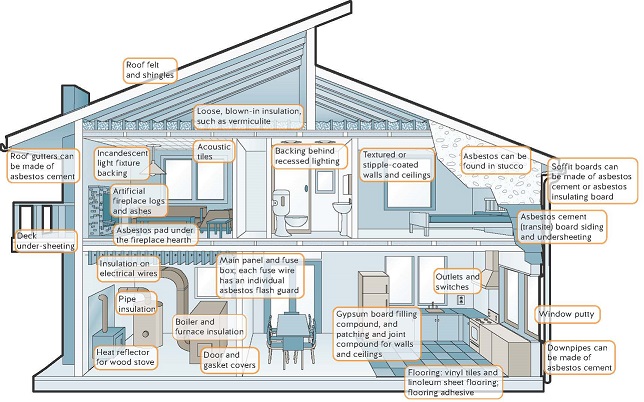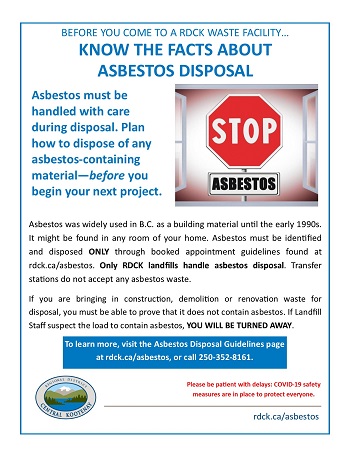Asbestos Disposal Guidelines
Asbestos was widely used in BC as a building material until the early 1990s. It might be found in any room of your home. If you are renovating your home and think you might have asbestos-containing material to dispose of, you can either:
- Get a certificate of analysis from an accredited lab from the last 30 days that shows the material does not contain asbestos, or
- Treat the material as asbestos-containing, and follow the Asbestos Dipsosal Process outlined below.
Asbestos is a Controlled Waste as listed in Schedule D of the Resource Recovery Regulatory Facilities Bylaw. The Regional District Central Kootenay (RDCK) only accepts asbestos waste generated within the RDCK for disposal. Asbestos must be brought to an RDCK landfill for disposal. Transfer Stations do not accept asbestos waste of any kind.
The RDCK requires Waste Manifest forms to be presented at the time of disposal of materials containing friable asbestos (friable asbestos crumbles, frays or breaks with little effort, non-friable asbestos can’t be damaged by the human hand). Waste Manifest forms can be purchased at FrontCounter BC Offices in Nelson at #401 - 333 Victoria Street and in Castlegar at 845 Columbia Avenue.
It is advised that home owners transporting and disposing of asbestos containing material review the Ministry requirements and read the Asbestos Management by Homeowners guide. It is further suggested that anyone working with asbestos containing materials review the WorkSafe BC website for safe handling and best practices.
Asbestos Disposal Process
*A mil is a measurement that equals one-thousandth of an inch, or 0.001 inch. One mil also equals 0.0254 mm (millimeter).
- Decide if you want to test for asbestos or simply treat the material as asbestos-containing.
- Prepare the material by bagging it in thick poly bags or bladder bags to a minimum of 12 mil thickness and clearly labelled ‘asbestos’. 3 mil and 4 mil poly bags can be purchased at most local hardware/building stores.
The yellow 6mil poly asbestos bags can be purchased from Trowelex in Castlegar and Kootenay Industrial Supply in Castlegar & Nelson.
- If using 6 mil bags - wrap the material 2 times to achieve the 12 mil thickness.
- If using 4 mil bags - wrap the material 3 times to achieve the 12 mil thickness.
- If using 3 mil bags - wrap the material 4 times to achieve the 12 mil thickness.
- Bags must be sealed so no particles can escape.
- Sealed drums are not acceptable asbestos waste containers. - Count the number of bags or determine the size of the bin (i.e. 20 yd) not the square footage or some other measurement.
- Contact the RDCK at (250) 352-8161 at least 48 hours (two [2] business days) in advanced of disposing of the asbestos waste. You will be required to provide your license plate number, the number of bags or size of bin requiring disposal, the address where the material is generated from, friable or non-friable, etc. This early notice lets the landfill prepare a safe burial trench for the waste.
- Wait to receive confirmation from RDCK's Environmental Services Department that your appointment has been scheduled.
- Arrive at the landfill at your appointment time, present Waste Manifest form (if asbestos is friable) and pay material tipping fee and special handling fee.
What is Asbestos?
- Asbestos is a naturally occurring fibre that is strong and resistant to heat, fire, and chemicals. It is contained in more than 3,000 building materials made before 1990. It is a known carcinogen (cancer-causing agent).
- In accordance with WorkSafeBC's Occupational Health and Safety Regulation, an "asbestos-containing material" is a material that contains asbestos fibres totalling 0.5% or more by weight at the time of manufacture, or at any time as determined by specialized laboratory analysis.
- All asbestos-containing materials must be handled with care during disposal.
What are the Risks of Handling Asbestos?
Anyone who repairs, renovates, or demolishes older buildings in B.C. is at risk of inhaling asbestos fibres. Found in dozens of items in older buildings, asbestos breaks down into small fibres as it ages or when it is disturbed. Touching or moving it releases the fibres into the air, where they can linger for hours.
Breathing in asbestos fibres damages your lungs, causing serious health problems. These include:
- Asbestosis
- Lung Cancer
- Mesothelioma (a cancer)
- Pleural thickening (a lung disease)
People exposed to asbestos won't develop illnesses right away. It takes years for your health to suffer. Research shows that smokers who inhale asbestos fibres greatly increase their risk of lung cancer.
Never assume a building material is free of asbestos. You can't tell just by looking at it. If you suspect asbestos is present, stop work immediately and have a qualified asbestos professional complete an asbestos survey or hazardous material assessment.
Reducing the Risk of Exposure to Asbestos
Personal Protective Equipment (PPE), including respirators, gloves and protective clothing, is essential in controlling exposure to asbestos. PPE should meeting the following minimum criteria:
- It is made of a material that resists penetration by asbestos fibres
- Covers the body and fits snugly at the neck, wrists and ankles
- Covers the head
- Covers the feet (laceless rubber boots are strongly recommended)
- Can be immediately repaired or replaced if torn
The use of disposable protective clothing is recommended.
Potential sources of asbestos
Materials that may be a source of asbestos include heat and noise insulation, fire-resistant materials, and cements and plasters.

Products that may contain asbestos include:
- Roof felt and shingles
- Acoustic ceiling tiles
- Drywall tape and mud
- Loose, brown insulation
- Pipe insulation
- Asbestos cement board siding and under sheeting
- Boiler and furnace insulation
- Stucco
- Outlets and switches
- Artificial fireplace logs and ashes
- Roof gutters
- Boiler and furnace
- Insulation on electrical wires
- Window putty
- Textured or stippled ceiling material
- Flooring, vinyl tiles and linoleum sheet flooring; flooring adhesive
- Door and gasket covers
- Gypsum board filling compound and patching and joint compound for walls and celings
If you want to dispose of material that may be asbestos-containing, you must have a certificate of analysis from an accredited laboratory from the past 30 days that show the material does not contain asbestos. Alternatively, you can treat the material as asbestos-containing and follow disposal requirements for asbestos.
Hazardous Material Assessment
Homeowners and contractors need to take precautions when disturbing or handling asbestos containing materials (ACM). To protect you and your family, it is recommended that you hire a qualified professional to identify asbestos and other hazardous materials before you renovate. Hazardous materials are identified through a Hazardous Material Assessment.
Below is a list of local companies that can assist with assessments:
- Apex EHS Services
277 Columbia Avenue
Castlegar, BC
PH: (250) 878-4232
http://www.apexehs.ca - Steer Environmental Associates Ltd.
1515 Holland Street
Nelson, BC
Email: info@steerenvironmental.com
http://steerenvironmental.com - Pinchin Ltd.
PO Box 846
Nakusp, BC
PH: (250) 265-1711
https://www.pinchin.com - Peak Environmental
951 Pinewood Place
West Kelowna, BC
PH: 1-877-518-7325
Email: info@peakenvironmental.ca
Test for Asbestos
If you suspect a product contains asbestos have the product tested at an accredited laboratory and get a certificate of analysis.
Find an accredited laboratory.
Asbestos testing is relatively inexpensive and can save you money at the Landfill. Each test costs starting between $25 to $50; depending on how soon you want the results. If the laboratory determines that your material does not contain asbestos, you have proof that you can dispose of the material as garbage. The rate for garbage disposal may be significantly cheaper than the rate for asbestos burial.
Certificate of Analysis
Your certificate of analysis must be from an accredited laboratory, be from within the past 30 days, and include a minimum of the following information:
- Contact Name
- Analyst Name
- Client Name
- Sample ID
- Asbestos type
- Asbestos amount
- Analytical method
- Material type tested
***If the analysis shows that the product does not contain asbestos, prepare and dispose of it at the landfill within 30 days of the test. Bring the results with you to the landfill. For assistance with this process please call 250.354.9781.
The content on this page was last updated February 9 2024 at 3:05 AM


